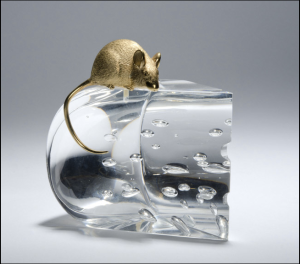 Cheese is not a mouse’s favorite fare—at least from my experience. Sunflower seeds rather than slivers of cheddar are the furry fellow’s food of choice. Yet there are countless stories to the contrary—perhaps because the image of a cheese-eating mouse is simply irresistible.
Cheese is not a mouse’s favorite fare—at least from my experience. Sunflower seeds rather than slivers of cheddar are the furry fellow’s food of choice. Yet there are countless stories to the contrary—perhaps because the image of a cheese-eating mouse is simply irresistible.
James Houston, artist and writer, appears to have agreed. In 1975, he created two small decorative sculptures, each of a mouse sitting atop a wedge of cheese. Since 1962 he had been a designer with the famed Steuben Glass Works, a division of Corning Glass in Corning, New York.
Houston was American, Canadian-born and -raised. Excelling in art from an early age he found a mentor in Arthur Lismer of Canada’s storied Group of Seven [landscape painters]. He attended the Ontario College of Art, and at age twenty-six, he took off to Paris, and continued his studies at L’Académie de la Grande Chaumière for almost a year—until his mother, like a fisherman with a taut line, reeled him back to Toronto, writing that whatever he was doing “there” was “making her terribly nervous.”[1] But Toronto wasn’t Paris, and he opted for adventure; he took the Hudson’s Bay Company ship to the Arctic in September 1947, and made first Inukjuak and later Baffin Island his home. Surviving the physical hardship of his initial five-month stay—enduring sub-zero temperatures and slipping through the ice on no fewer than five different occasions—he fell in love with the indigenous people; one later told him, “We sometimes thought we’d have to give you away. We didn’t know what to do with you, you were so clumsy.” He learned the language and absorbed the way of living of the Eskimos (as he preferred to call them, that to him using the word “Inuits” was silly unless you’re speaking their language, something akin I guess to English-speakers calling Germans, die Deutschen). He drew their portraits, their birds and their fish, often gifting them with his sketches. He began collecting their soapstone carvings and sculptures, acquainted them with the printmaking process, and helped them by creating a market for their work; he became the biggest champion of contemporary Eskimo art.[2]
He had been living in the Arctic for almost twelve years when he met Corning Glass’s president, Arthur Houghton, who had arrived on Baffin Island as a member of the very first tourist group to the eastern Canadian Arctic. Instantly captivated by Houston’s drawings, impressed by his artistic skill, Houghton offered him, open-ended, a design job. Three years later, Houston, realizing that it was time for him to come in from the cold, finally accepted the offer, and became Steuben’s leading designer. Houghton said that Houston was “the most prolific and the most successful designer that Steuben ha[d] ever had.”
Houston’s specialty was “Major Ornamentals,” in which he often merged crystal with precious metal in his designs. The majority of his works feature either Eskimos or wildlife of the Arctic region—polar bears, salmon and seals, for example. He said that at times his ideas came in an instant from recognizing a particular animal’s shape in the molten glass on the end of the blowing iron. Perhaps it was in 1975 when he saw in a hot glob of crystal with tiny air bubbles, a piece of Swiss cheese—the perfect partner for a small 18k gold mouse.
.
[1] Quotes and primary source: see Mary D. Kierstead’s excellent profile of Houston, “The Man,” The New Yorker, August 29, 1988,
[2] Margalit Fox, “James A. Houston,” The New York Times, April 22, 2005.
(Image: Mouse and Cheese, designed by James Houston, 1975; Colorless lead glass, 18k gold, 4 x 3 13/16 x 3 1/4 inches. Made by Steuben Glass, of Corning Glass Works. Collection of the Philadelphia Museum of Art. Reproduced for non-commercial use only.)
Leave a comment